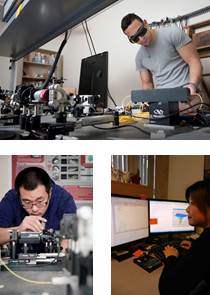Summer 2022 USRA Opportunities
1) Laser Tracking System
2) Digital Adaptive Optics
3) Volumetric image registration
Background: Non-invasive imaging provides
the ability to look under the surface of samples without causing damage. Techniques like CT, MRI, and ultrasound are useful for whole body imaging, and microscopes are used for looking at cells. There is a missing layer between them for studying features of intermediate scale, on the order of millimeters. An emerging technique for imaging is called Optical Coherence Tomography (OCT)
which is similar in principle to ultrasound, but uses light instead of sound
waves. OCT systems have resolution and imaging depth intermediate between
microscopy and high frequency ultrasound, filling an important technological
gap. OCT is widely used to image eyes (ophthalmology), diagnose cancer, and
also as a tool to augment studies in developmental biology.
Our group research applies core engineering technology for image acquisition and analysis. This work involves a combination of electronics (detectors, motion control, scanners, etc) and programming (system control, signal and image processing, etc).
All projects for the Summer 2022 term will be completed remotely. There will be no in person / on campus aspects to these projects. Regular (daily) interaction with the group will be through Zoom and other online communication programs.
Skills: high-level language programming skills (eg C, C++, C#) are a must. Minimum requirements are completing of ENSC 251, or equivalent. Experience with GPU programming would be an asset.
Our group research applies core engineering technology for image acquisition and analysis. This work involves a combination of electronics (detectors, motion control, scanners, etc) and programming (system control, signal and image processing, etc).
All projects for the Summer 2022 term will be completed remotely. There will be no in person / on campus aspects to these projects. Regular (daily) interaction with the group will be through Zoom and other online communication programs.
1) Laser Tracking System
Objectives: This research project will develop a high-speed image tracking system for guiding the position of a laser during real-time image acquisition. The initial modules the student will be designing will focus on furthering the existing work on real-time image segementation and feature tracking. Additional work will include controlling mirror based scanners to position the laser on the selected feature(s) in the images. This project will strengthen the student's software design skills in real time applications. Understanding optics and lasers is not required, but completion of advanced programming courses would be a plus.Skills: high-level language programming skills (eg C, C++, C#) are a must. Minimum requirements are completing of ENSC 251, or equivalent. Experience with GPU programming would be an asset.
2) Digial Adaptive Optics
Objectives: The purpose of this project is to learn about high resolution imaging using adaptive optics (AO). The same AO technology that is used for sharpening the focus of telescopes can also be used for high resolution microscopy. The purpose of AO is to correct aberrations (wavefront distortions) in order to obtain diffraction limited imaging performance. In addition to hardware based approaches to aberration correction, software approaches can also be used in certain circumstances. The student will participate in on-going development of a digital signal processing approach to aberration correction similar to autofocus on a camera, but also correcting higher order aberrations. The first portion of the project will focus on developing and understanding of the theory, followed by concentration on scientific programming on 'holographic' (amplitude and phase) image data .Skills: Students that have completed the undergraduate courses in MATH (ie 251, 254) and E&M (ENSC 316, ENSC 470) are preferred.
3) Deep Learning Image Analysis
Objectives: The purpose of this project is to learn about advanced image processing using Deep Learning. Representative projects include investigation of 'superresolution' techniques, high resolution image registration, and multi-volume averaging. As an example of image registration, some features from images can only be revealed by averaging many (10's or 100's of images). However, in the presence of motion, correction of distortion to match up landmarks in the images is required. Due to the large number of volumes to be processed, the majority of the work will be performed using parallel processing techniques in the 'cloud' using the Canadian supercomuting cluster 'Cedar'. Experience with MatLab and Pyhton for basic image pre-processing and Deep Learning is essential.Skills: Minimum requirements: ENSC 380. Preference will be given to students that have completed other undergraduate courses on signal or image processing, such as ENSC 474.

